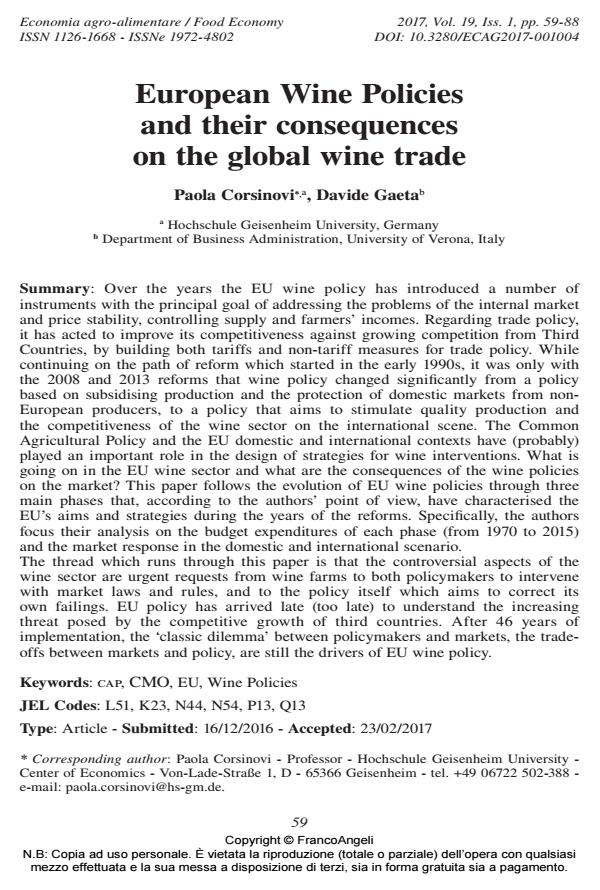European Wine Policies and their consequences on the global wine trade
Journal title ECONOMIA AGRO-ALIMENTARE
Author/s Paola Corsinovi, Davide Gaeta
Publishing Year 2017 Issue 2017/1
Language English Pages 30 P. 59-88 File size 293 KB
DOI 10.3280/ECAG2017-001004
DOI is like a bar code for intellectual property: to have more infomation
click here
Below, you can see the article first page
If you want to buy this article in PDF format, you can do it, following the instructions to buy download credits

FrancoAngeli is member of Publishers International Linking Association, Inc (PILA), a not-for-profit association which run the CrossRef service enabling links to and from online scholarly content.
Over the years the EU wine policy has introduced a number of instruments with the principal goal of addressing the problems of the internal market and price stability, controlling supply and farmers’ incomes. Regarding trade policy, it has acted to improve its competitiveness against growing competition from Third Countries, by building both tariffs and non-tariff measures for trade policy. While continuing on the path of reform which started in the early 1990s, it was only with the 2008 and 2013 reforms that wine policy changed significantly from a policy Based on subsidising production and the protection of domestic markets from non-European producers, to a policy that aims to stimulate quality production and the competitiveness of the wine sector on the international scene. The Common Agricultural Policy and the EU domestic and international contexts have (probably) played an important role in the design of strategies for wine interventions. What is going on in the EU wine sector and what are the consequences of the wine policies on the market? This paper follows the evolution of EU wine policies through three main phases that, according to the authors’ point of view, have characterised the EU’s aims and strategies during the years of the reforms. Specifically, the authors focus their analysis on the budget expenditures of each phase (from 1970 to 2015) and the market response in the domestic and international scenario. The thread which runs through this paper is that the controversial aspects of the wine sector are urgent requests from wine farms to both policymakers to intervene with market laws and rules, and to the policy itself which aims to correct its own failings. EU policy has arrived late (too late) to understand the increasing threat posed by the competitive growth of third countries. After 46 years of implementation, the ‘classic dilemma’ between policymakers and markets, the tradeoffs between markets and policy, are still the drivers of EU wine policy.
Keywords: Cap, cmo , EU, Wine Policies
- Assessing Consumer Behavior in the Wine Industry and Its Consequences for Wineries: A Case Study of a Spanish Company Rosa M. Muñoz, M. Valle Fernández, Maria Yolanda Salinero, in Frontiers in Psychology 2491/2019
DOI: 10.3389/fpsyg.2019.02491 - It's a jungle out there - the strange animals of economic organization in agri-food value chains P. Corsinovi, D. Gaeta, pp.303 (ISBN:9789086868445)
- Consumer Taxes on Alcohol: Is the Wine Sector a Niche Within the Alcoholic Beverages? Paola Corsinovi, in Italian Economic Journal /2021 pp.341
DOI: 10.1007/s40797-021-00146-3 - Institutional impulse in wine innovation within the EU framework programs Marta Meleddu, Marilena Vecco, Angelina De Pascale, in Journal of Wine Research /2025 pp.236
DOI: 10.1080/09571264.2025.2537011 - Real and Financial Sectors in Post-Pandemic Central and Eastern Europe Jana Katunar, Maja Grdinić, Dario Maradin, pp.109 (ISBN:978-3-030-99849-3)
- Strategies for Global Promotion of Chinese Yellow Wine: History, Present, and Future Development Chuanli Liu, Xuecan Yang, Ying Zhang, Jean-Marie Nianga, Zefeng Wang, in Economic Society and Humanities /2024 pp.116
DOI: 10.62381/E244515
Paola Corsinovi, Davide Gaeta, European Wine Policies and their consequences on the global wine trade in "ECONOMIA AGRO-ALIMENTARE" 1/2017, pp 59-88, DOI: 10.3280/ECAG2017-001004